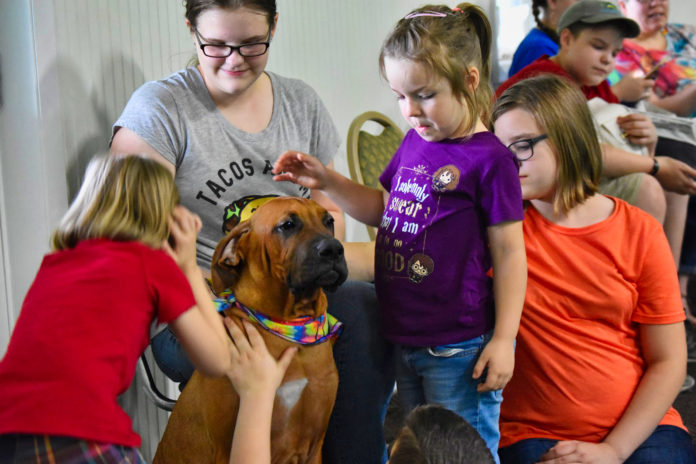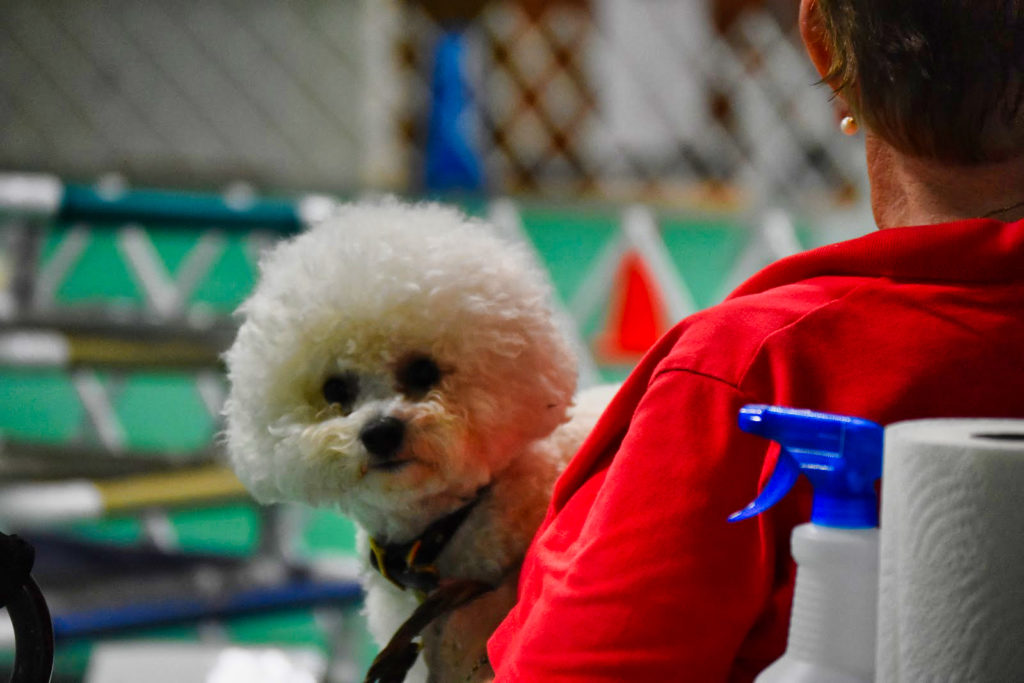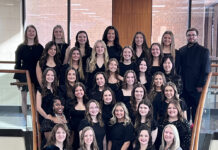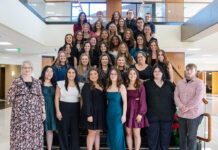
TRIMBLE, Ala. – Paula Kretzschmar is a dog person, and that’s putting it mildly. On a quiet little west Cullman County back road, the retired educator lives on a homestead that’s part house, part country retreat and part canine arena. Saturday, she hosted a group of dog owners from across north Alabama, who brought their animals for judging by an American Kennel Club (AKC) evaluator as candidates for the organization’s Canine Good Citizen (CGC) certificate.
The dogs had to complete basic obedience tasks like walking, turning and circling on a leash, sitting and staying, but also had to walk through a crowd, encounter another dog and be subjected to a sudden loud noise without getting spooked. They had to behave themselves while meeting a stranger who wanted to pet and groom them, and even had to sit quietly with a stranger for three minutes while their handler disappeared from the arena: no barking, no trying to run away, and, as one participant observed, no eating the stranger!
Elena Caudle, who had her 4-month-old Tosa Inu/Japanese Mastiff puppy Enishi along for his first evaluation, explained, “The CGC is, basically, to show that the dogs can be in public safely, have been trained and are controllable in public.”
Some of the dogs went through an additional Trick Dog evaluation, performing five puppy stunts chosen from a long list of possibilities. They walked elevated beams, navigated tunnels, jumped bars, shook hands, gave high fives and kisses and displayed an array of other skills to get their ribbons and certificates.
While kennel clubs are often best known for fancy dog shows with best of breed, best of group and best of show awards, events like CGC and Trick Dog are open to all breeds, crossbreeds, mixed breeds and even what-the-heck-is-that breeds. Several purebred dogs came out Saturday, but the event also hosted a strong contingent of “doodles,” hybrids of poodles and golden or Labrador retrievers.
For four of the dogs there Saturday, there was much more on the line than just a ribbon or certificate. Kretzschmar is a tester/observer (TO) for the Alliance of Therapy Dogs (ATD), a national organization that gives hospitals, nursing homes and assisted living facilities, schools and businesses access to certified and insured therapy dogs. While the dogs were going through their CGC evaluation, she was at ringside, observing for herself. As the canines were proving their status as good citizens, they were also completing the first of four steps in becoming certified ATD therapy dogs.
Once candidates complete CGC or another evaluation that shows a good relationship between dog and handler, as well as good temperament on the part of the dog, the dog/handler team will make visits to three facilities (two of them medical) where therapy dogs are commonly used, under the supervision of the TO. If all goes well during those visits, the team is recommended for certification.
According to Kretzschmar, ATD currently has 12 certified dogs in north Alabama with fewer handlers, since a few handlers have two dogs each. Four more dogs and three new handlers are in the certification process. More puppies, like Caudle’s Enishi, are biding their time, waiting until they reach the 1-year minimum age requirement for the program.
The active dogs are visiting nursing homes, assisted living facilities, hospitals, public and private schools, public libraries and even businesses whose employees could use a little stress reduction. They often provoke nursing home and assisted living residents into reminiscing and sharing stories about pets of their childhoods, as well as pets they left behind when moving into the facility.
Said Kretzschmar, “At the nursing home, a lot of it is folks who are missing their dog, that they can’t have their dog with them.”
She shared, “We are invited into the schools. I did Reading Day at Cleveland Elementary (Blount County), where I went over- it was Dr. Seuss Week, and we did “Fox in Socks;” (my poodle) Luke wore socks and I did, too.
“Anywhere we’re invited, that’s the main thing.”
ATD dogs are not response dogs; they aren’t trained to alert on early signs of medical distress or things like that. Their primary purpose is emotional support: just making people’s day a little brighter.
For more information on ATD, visit www.therapydogs.com.
Copyright 2019 Humble Roots, LLC. All Rights Reserved.

Paula Kretzschmar’s Bichon Frise Louie knows what the camera’s for! (W.C. Mann for The Cullman Tribune)

Paula Kretzschmar brought poodle Luke and Bichon Frise Louie out to the ATD tent at July’s pet-friendly 2nd Fridays event in Cullman. (Photo courtesy of Elena Caudle)




















